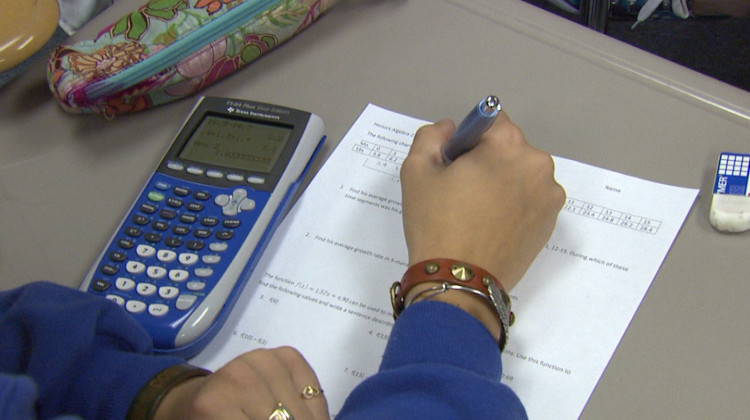
Just more than a quarter of Indiana 11th graders scored college-ready on the math portion of the SAT in 2024.
FILE PHOTO: WFIU / WTIUEleventh graders in Indiana take the SAT, a standardized college-readiness test, to comply with state law. This year, the percentage of students who earned college-ready scores increased in reading and writing but decreased severely in math.
There are three SAT score ranges: below college ready, approaching college ready and at college ready.
Lynn Schemel, the chief academic officer at the Indiana Department of Education, said SAT scores are down nationally. The College Board, a non-profit organization that administers the SAT, changed the test design last school year, and Schemel said that might account for some lower scores.
The new test is more adaptive and uses an item response theory scoring method. All students have a range of easy, medium and hard questions in the first section. If they do well, they’ll get harder questions. If they perform poorly, the questions in the next session will be easier.
Scores will be based on the difficulty of the questions as well as the number of right answers, so students who answer the same number of questions correctly could have different scores.
“Each module has the same number of items, the same amount of time, and students have the same opportunity to reach that at-college benchmark,” Schemel said.
The new format is supposed to measure student performance more accurately, but IDOE said it takes time to adjust.
Join the conversation and sign up for the Indiana Two-Way. Text "Indiana" to 765-275-1120. Your comments and questions in response to our weekly text help us find the answers you need on statewide issues and the election, including our project Civically, Indiana.
About 51.8 percent of Indiana students scored college ready on the reading and writing portion of the test, a 1.3 percent increase from last year.
However, Black students passed at much lower rates than their peers at 27.2 percent. Special education students and English language learners also struggled with pass rates at 17 and 8.6 percent, respectively.
Compared to last school year, math scores dropped significantly overall. Schemel said this year, more than half of students scored below college-ready in math.
About 25.2 percent of students passed the math portion of the SAT, down from 30.7 percent last year.
“The SAT mathematics mean scores also decreased nationally in 2024,” Schemel said. “The mean score decreased 18 points in Indiana versus 8 [points] nationally.”
Schemel said there could be another factor causing low test scores for Indiana students: chronic absenteeism.
Students who were absent from school for more than 10 percent of the year, or about 18 days, passed at considerably lower rates than students who did not miss school. Only 17.5 percent of students who were chronically absent scored college-ready on the SAT, compared to 41.1 percent of their peers.
IDOE said Indiana will work to align state standards and the SAT, and improve chronic absenteeism to boost scores. It will also support professional development for teachers and promote College Board workshops about SAT test design and data analysis.
Kirsten is Indiana Public Broadcasting's education reporter. Contact her at kadair@wfyi.org or follow her on Twitter at @kirsten_adair.
 DONATE
DONATE






 Support WFYI. We can't do it without you.
Support WFYI. We can't do it without you.